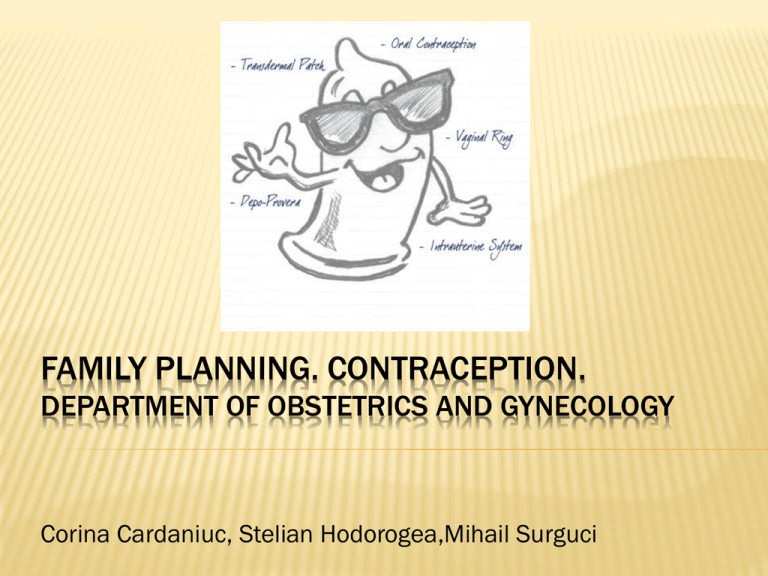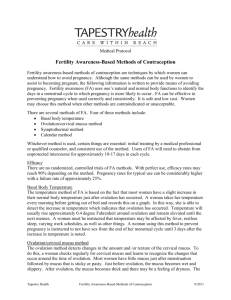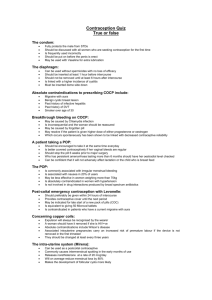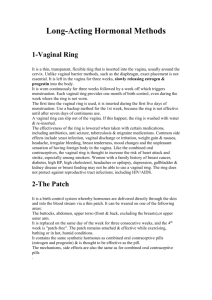Family planning. Contraception.
advertisement

FAMILY PLANNING. CONTRACEPTION. DEPARTMENT OF OBSTETRICS AND GYNECOLOGY Corina Cardaniuc, Stelian Hodorogea,Mihail Surguci FAMILY PLANNING. CONTRACEPTION. Reasons of family planning: pregnancy planning limiting the number of children avoiding medical risks of pregnancy controlling the world population FAMILY PLANNING. CONTRACEPTION. Birth control techniques and methods include: Contraception (the prevention of fertilization), Contragestion (the prevention of blastocyst implantation) and Abortion (the removal or expulsion of a fetus or embryo from the uterus). FAMILY PLANNING. CONTRACEPTION The ideal contraceptive should be safe, harmless, and not interfere with the sexual enjoyment of either partner. The failure rate of any method of contraception is judged by the Pearl Index (PI): the number of women having regular intercourse who become pregnant within a year out of 100 couples using the method. Number of pregnancies PI= --------------------------------------------- x 100 Number of couples using the method FAMILY PLANNING. CONTRACEPTION There is no perfect contraceptive. All contraceptives have advantages and disadvantages, which must be integrated carefully with the patient’s status. Therefore, careful individualization is necessary to avoid undesirable side effects and to optimize patient acceptance. METHODS OF CONTRACEPTION BEHAVIORAL ALTERNATIVES Coitus interruptus ("interrupted sexual intercourse"), is the practice of ending sexual intercourse before ejaculation. This is the oldest and a widely practiced method. Is moderately effective in preventing pregnancy. Average Failure Rate: 27% Advantages: - requires no devices - involves no chemicals or artificial hormones - is available in any situation at no cost Disadvantages : - the occurrence of pregnancy from semen escaping before ejaculation or semen deposition at the vaginal introitus - may prevent complete satisfaction to both partners - does not offer complete protection from STDs BEHAVIORAL ALTERNATIVES Total abstinence Abstinence is 100% effective in preventing pregnancy AVERAGE COST: No cost Advantages: - almost 100% effective - protection against STD's - free - no prescription is needed LACTATIONAL AMENORRHEA METHOD (LAM) The lactational amenorrhea method (LAM) is a method of avoiding pregnancies which is based on the natural postnatal infertility that occurs when a woman is amenorrheic and fully breastfeeding. If not combined with chemicals or devices, LAM may be considered natural family planning. EFFECTIVENESS: 98% if no menses has occurred, only breast feeding is used to feed the baby, at least every four hours during the day and every six hours through the night, or prior to six months of age for the baby LACTATIONAL AMENORRHEA METHOD (LAM) ADVANTAGES: - effective immediately - does not interfere with intercourse - no side effects - no cost - gives infants passive immunity - decreased post-partum bleeding DISADVANTAGES: - offers no STD protection - highly effective only until period returns or up to 6 months - may need to use a lubricant because of vaginal dryness - must feed on demand and at least 6-10 times a day including night feedings - not reliable if period has returned. NATURAL FAMILY PLANNING Natural birth control methods teach women to determine the fertile phase of their menstrual cycle. Four Basic Methods: basal body temperature, cervical mucus changes, excretion of LH (luteinizing hormone - the ovulation triggering hormone) and menstrual calendars The BEST METHOD is to combine all of them into one called the Sympto-Thermal Method BASAL BODY TEMPERATURE METHOD The woman should refrain from intercourse seven days before the temperature rise until four days after. Temperature changes do not predict ovulation before it happens. To be completely safe, the woman should consider unsafe days from the first day of your period until the fourth day after the temperature rise. BASAL BODY TEMPERATURE Basal body temperature is the body temperature measured immediately after awakening and before any physical activity has been undertaken. In women, ovulation causes an increase of one-quarter to onehalf degree Celsius in basal body temperature (BBT). Monitoring of BBTs is one way of estimating the day of ovulation. The tendency of a woman to have lower temperatures before ovulation, and higher temperatures afterwards, is known as a biphasic pattern. CERVICAL MUCUS METHOD Checking the cervical mucus for consistency may assist in determination of ovulation. After the period, there are a few days when there is no mucus. These are called dry days and are safe. Then the mucus changes to the slippery, clear pattern a few days before ovulation. This is the beginning of an unsafe (THE MOST UNSAFE) time. The amount of mucus becomes the greatest just before ovulation. CERVICAL MUCUS METHOD Finger Testing A finger-tip is used to test the capacity of the cervical mucus to stretch. It may feel sticky and break easily, or it may feel smoother and slippery like raw egg white and stretch between the thumb and first finger, from a little up to several inches before it breaks. FINGER TESTING Sensation at Vulva Finger Test Appearance Moist or Sticky Early Mucus Scanty Thick White Sticky Holds its shape Wetter Transitional Mucus Increasing Amounts Thinner Cloudy Slightly Stretchy Slippery Highly Fertile Mucus Profuse Thin Transparent Stretchy (like raw egg white) THE CALENDAR METHOD The calendar method is based on working out the fertile period from previous cycles (by careful documentation of the woman’s menstrual cycle). This method is also known as the 'Rhythm Method'. Average Failure Rate: 13-20% For a woman with very regular cycles, it may be possible to predict the day of ovulation. The unsafe period lasts from 7 days before the day of ovulation to 4 days after ovulation. DETERMINATION OF LH SURGE The laboratory determination of abrupt surge of LH and progesterone with ovulation is the most reliable method of determining ovulation. Ovulation predictor kits can be used with the temperature charts to more accurately pinpoint your day of ovulation. They work by detecting the small amounts of LH that is present in the urine before ovulation. There is a rise in the amount of LH in the body approximately 24 hours before ovulation. This increase is registered by a color change. NATURAL FAMILY PLANNING Effectiveness 95-98% effective with perfect use 75-88% for typical use Benefits Has no negative health side effects An alternative for women who cannot or do not want to use hormonal methods Consistent with many religious beliefs and lifestyles Encourages male involvement Disadvantages Provides no protection from sexually transmitted infections Requires time to learn (usually 3 to 6 cycles) Requires discipline to chart fertility signs and follow the rules to avoid pregnancy Difficult to use with irregular periods. Illness can alter temperature. Vaginal infections can alter cervical mucus changes BARRIER CONTRACEPTION MECHANICAL Barrier methods place a physical impediment to the movement of sperm into the female reproductive tract. MALE CONDOM Male Condom Is penile sheath made of latex or polyurethane or animal membrane that serves as a barrier. Mechanism of action: Prevents sperm from reaching the cervix. The addition of a vaginal spermicide makes the method very effective. EFFECTIVENESS: 80-90% (INCREASES IF USED WITH SPERMACIDE); Advantages: Widespread availability Low cost Protection against STD No prescription needed Safe Fertility returns upon discontinued use Disadvantages: manufacturing defects; if withdrawal of the penis occurs after detumescence, semen may leak into the vagina both partners may complain of decreased sensation during intercourse woman may be allergic to spermacidal or latex. can be used only once may interfere with spontaneity FEMALE CONDOM Female condom is a latex or polyurethane membrane (bag) that can be inserted into the vagina. It has a higher rate of pregnancy than the male condom. EFFECTIVENESS: 75-85% AVERAGE ADVANTAGES: Protects against some sexually transmitted diseases No prescription needed Fertility returns immediately upon discontinued use Can be inserted anytime - up to eight hours before intercourse Medically safe DISADVANTAGES Decreased vaginal sensation May be difficult to insert THE CERVICAL CAP The cervical cap is a barrier device covering the cervical portion. The cervical cap is the smallest cervical barrier. It is made of rubber or plastic. Depending on the type of cap, it stays in place by suction to the cervix or to the vaginal walls. Cervical caps should not be left in place for >48-72 hours to avoid infection. The cap must be used with a spermicide, which destroys sperm. EFFECTIVENESS: 85% for women who have never a a baby 70% for women who have had a baby ADVANTAGES Safe Fertility returns immediately with discontinued use Disposable cap does not need to be fitted nor needs a prescription Can be inserted several hours before intercourse THE CERVICAL CAP DISADVANTAGES Must be individually molded for every patient because cervical anatomy varies greatly Limited sizes available Must be left in place 6-8 hours after intercourse Must be used each time May become dislodged Some women may be allergic to spermicides, latex Need more frequent pap smears the first 1-2 years of use because it may cause changes in the cells of the cervix It doesn't protect against STIs, and the cap itself isn't protective MUST stay in place at least 8 hours after the last sex act VAGINAL DIAPHRAGM Vaginal diaphragm is a soft, rubber dome that forms a barrier to prevent sperm from reaching the cervix. It covers the cervix and is held securely in place behind the pubic bone and rear wall of the vagina. They are made in various sizes and for maximum safety must be used with a spermicide jelly or cream. EFFECTIVENESS: 85% ADVANTAGES Safe Fertility returns immediately with discontinued use Can be inserted 2-3 hours before lovemaking May reduce the risk of cervical cancer Some STD protection VAGINAL DIAPHRAGM DISADVANTAGES Must be fitted by a health care professional Needs prescription Must be left in place 6-8 hours after intercourse but no more than 24 hours Must be used each time May become dislodged Some women may be allergic to spermicides, latex Must be replaced periodically Must apply spermicide with each new act of intercourse May have an increase in urinary tract infections May decrease spontaneity CHEMICAL CONTRACEPTIVES Douching after coitus Douching immediately after intercourse is a time honoured but ineffective method. The intent of the method is to wash semen out of the vagina before sperm can enter the cervix. It does not affect those sperm which have already passed up the cervical canal. SPERMICIDES Spermicides contain a chemical called nonoxynol-9. It comes in the form of cream (only for use with diaphragms), gel, foam, film, or suppository. All of these agents require insertion into the vagina before each coitus. By inserting spermicide in the vagina, in front of the cervix, it destroys sperm on contact. EFFECTIVENESS: 80% ADVANTAGES Available without a prescription No known risk to general health Fertility returns immediately upon discontinued use Some protection from bacterial infections and pelvic inflammatory disease DISADVANTAGES: Less effective than other methods Must wait 8 hours before taking a bath or douche Usually last only one hour Side effects: Vvginal irritation, some women are allergic to spermicides Need insertion at least ten minutes before intercourse Nonoxynol-9 does not protect against STIs CONTRACEPTIVE SPONGE The sponge is a soft, round barrier device that is about two inches in diameter. It is made of solid polyurethane foam, contains spermicide, and has a nylon loop attached to the bottom for removal. The sponge must first be moistened with water and then the woman inserts it into her vagina before intercourse. It covers the cervix (opening to the uterus), and it blocks sperm from entering it. The sponge also releases a spermicide that can immobilize sperm, thus, preventing the sperm from reaching an egg. EFFECTIVENESS: 75 – 85% ADVANTAGES Fertility returns immediately upon discontinued use Can be inserted several hours prior to intercourse It provides 12-hour protection It contains three types of spermicide and does not appear to be allergenic nor as irritating as previous sponges Does not require a prescription May protect against some STD's Does not require insertion of a new sponge for each act of intercourse DISADVANTAGES: Cannot be used by women allergic to nonoxyl-9 or those who have had toxic shock syndrome a higher risk of vaginal yeast infections HORMONAL CONTRACEPTIVES COMBINED ORAL CONTRACEPTIVES Most combination oral contraceptives are packaged as "active pills" for 21 days followed by a seven day pill-free or "inactive" pill interval to allow for withdrawal bleeding (menstruation). The seven inactive pills are usually in another color. Monophasic OCs contain the same amount of each hormone in each active pill. Biphasic OCs alter the progestin-estrogen ratio in two phases. Triphasic OCs alter the progestin-estrogen ratio in three phases by varying the amounts of progestin, estrogen, or both. Biphasic and triphasic regimens attempt to approximate a woman's natural hormonal fluctuations more closely by varying the progestin-estrogen ratios. One important goal of these formulations is to minimize the occurrence of irregular bleeding while maintaining efficacy. EFFECTIVENESS 96-99% COMBINED ORAL CONTRACEPTIVES Mechanism of action: Combination hormonal contraceptives act by suppression of gonadotropins. Although the primary effect of this action is inhibition of ovulation, other alterations include changes in the cervical mucus (which increase the difficulty of sperm entry into the uterus) and the endometrium (which reduce the likelihood of implantation). ADVANTAGES Reduces the risk of ovarian and uterine cancer Reduces the risk of pelvic inflammatory disease Reduces the risk of ovarian cysts May decrease: pre-menstrual syndrome, acne, bleeding, anemia less breast tenderness Does not interfere with intercourse DISADVANTAGES Does not protect against STD's Must be taken daily Cannot be used by those with a history of: breast cancer, blood clots or at risk to develop blood clots, liver disease, kidney disease, unexplained uterine bleeding, smokers over age 35, melanoma Should not be used by those with: light periods, high blood pressure, diabetes, migraine headaches, depression, sickle cell disease, fibroids Serious side effects (rare): blood clots, liver disease, high blood pressure, migraine headaches Common side effects include: loss of libido, nausea, breast tenderness, mid-cycle bleeding the first few months, weight gain, increased appetite, mood swings, depression, headaches, skin problems Hormonal contraceptives may increase the risk of breast and cervical cancer PROGESTIN-ONLY ORAL CONTRACEPTIVES The Mini-Pill Progestin-Only Pills (POP), are estrogen-free oral contraceptive pills taken daily to prevent pregnancy. The estrogen-free mini-pill has fewer unwanted side-effects than traditional combined oral contraceptives. Mini-pils are less effective and can cause irregular menstruation. Popular brands of progestin-only pills include Micronor, Nora-BE (0.35 mg norethindrone). Estrogen-free oral contraceptives are available by prescription only. The mimi-pil always comes in 28-day packs, and all the pills within a pack contain the same progestin. Average Failure Rate: 1 - 13% PROGESTIN-ONLY ORAL CONTRACEPTIVES BENEFITS May be recommended to breastfeeding women Mini-pills are also considered safer than combined OCs, as many of the vascular risks are greatly reduced with the omission of the estrogen component. That means less risk for older women, smokers, and those with heart problems. SIDE EFFECTS ectopic pregnancy depression menstrual cycle disturbances Oral contraceptives do not protect against STDs oral contraceptives increase the risk of acquiring HIV from an infected partner CONTRACEPTIVE PATCH The contraceptive patch (Evra®) is a 4 cm x 4 cm beige patch that sticks to a woman's skin and continuously releases the hormones estrogen and a progestin into the bloodstream. Each patch is worn on the skin for seven days. One patch is worn each week for 3 weeks. The Patch should be changed on the same day each week (called the "Patch Change Day"). The patch can be worn on the buttocks, back or upper arms, but not on the breasts. Mechanism of action The Patch prevents pregnancy by stopping the ovaries from releasing an egg, and it may also thicken the cervical mucus and make the uterine lining thin. Effectiveness: the Patch is more than 99% effective at preventing pregnancy when used perfectly Benefits a regular, lighter period less PMS and cramping reduces the risk of endometrial and ovarian cancers helps to prevent benign ovarian cysts It is completely reversible Disadvantages does not protect against sexually transmitted infections side effects: breakthrough bleeding (between periods), breast tenderness, headaches, nausea VAGINAL RING (NUVARING) NuvaRing is a thin, transparent, flexible ring that stays in the vagina, usually around the cervix. The ring is worn continuously for three weeks followed by a week off which triggers menstruation. Each vaginal ring provides one month of birth control, even during the week when the ring is not worn. The ring slowly releases on average 0.12 mg/day of etonogestrel and 0.015 mg/day of ethinylestradiol. The walls of the vagina absorb the hormones and distribute them into the bloodstream. These hormones work by stopping ovulation, thickening cervical mucus as a barrier to sperm, and preventing implantation of the embryo if fertilization occurs. Average Failure Rate: 8% Benefits: In addition to preventing pregnancy, the ring has the added benefit of making a woman's periods more regular, lighter, and possibly less crampy. It is thought to have similar benefits as the birth control pill, such as treating PMS, endometriosis and acne, and preventing ovarian and endometrial cancers but these haven't been studied. It is completely reversible. Side Effects Headaches, vaginal irritation, discomfort or discharge, nausea, breast tenderness, breakthrough bleeding (bleeding between periods), especially in the first few months, yeast infection the vaginal ring is thought to increase the risk of heart attack and stroke, especially among smokers Contraindications: heart attack, stroke or breast cancer, active liver disease, women over 35 years old who smoke, women with a history of cancer, diabetes, high blood pressure, high cholesterol, headaches or epilepsy, depression, breastfeeding DEPO-PROVERA INJECTABLE CONTRACEPTIVE Depo Provera is a hormone (progesterone only) injection that a female takes every 12 weeks to prevent pregnancy. Depo-Provera is estrogen-free, which means that it is safer and has fewer serious side-effects than other hormonal methods. EFFECTIVENESS: 99% Mechanism of action prevents ovulation affects the cervical mucous, making it more difficult for the sperm to penetrate the cervix causes a thinning of the endometrium which prevents the egg from implanting. ADVANTAGES: One injection every 3 months Highly effective long-lasting helps protect against uterine cancer safe after childbirth and while breast-feeding May decrease menstrual cramps Does not interfere with intercourse DISADVANTAGES Does not protect against STD's Long-acting: fertility returns 6-24 months after last injection (an average of 9 months) Cannot be used by women with: blood clots, breast cancer, liver problems, unexplained uterine bleeding May not be good for women with: family history of breast cancer, abnormal mammogram, irregular or light periods, high blood pressure, migraine headache's, asthma, epilepsy, diabetes, depression Can cause bone density loss Irregular bleeding Weight gain NORPLANT® IMPLANTS Implanon is a type of long-term birth control that is inserted under the skin by a doctor. The implant consists of one to six match-sized plastic rods which are surgically placed under the skin of a woman's upper arm. Implanon contains a synthetic progestin hormone called etonogestrel. Implanon is effective for up to 3-5 years. Average Failure Rate: less than 1% Mechanism of action: The primary way is by stopping release of an egg from the ovaries. Implanon also changes the mucus in the cervix and this may keep sperm from reaching the egg. Implanon also has post-fertilization mechanisms, whereby the hormone changes the lining of the uterus, making it harder for a fertilized egg to implant and develop. ADVANTAGES The birth control effect is immediate Works up to five years or until removed Capsules can be removed anytime Fertility returns immediately upon removal of implants Helps protect against uterine cancer Can be safely used after childbirth and while breast-feeding Does not interfere with intercourse DISADVANTAGES Cannot be used by women with liver disease, breast cancer, unexplained uterine bleeding, blood clots May not be good for women with high blood pressure, gall bladder disease, elevated cholesterol, irregular periods, light periods, headaches, heart disease, seizure disorders. Cannot be used by women who have a history of certain types of high blood pressure, breast cancer, unexplained vaginal bleeding, liver growths, blood clots in veins, possible pregnancy increased risk of ectopic pregnancy implant does not offer any protection from STDs Side effects: irregular bleeding, prolonged periods, light periods, hair loss, decreased interest in sex, acne, depression, prolonged time between periods, weight gain, breast pain, headache INTRAUTERINE DEVICE The intrauterine device, or IUD, is a small plastic or metal birth control device that is placed inside the uterus for long term pregnancy protectionan. Types of IUD Mirena Intrauterine System (hormonal) Copper T IUD (hormone-free) COPPER T IUD This IUD is a non-hormonal birth control and contains copper. The IUD may prevent pregnancy by interfering with: sperm movement (the ability of the sperm to fertilize the egg) or implantation (nesting of a fertilized egg into the lining of the uterus). EFFECTIVENESS: Copper-T IUD - 99% ADVANTAGES Requires no attention except for monthly checks for the string Fertility returns immediately upon removal Does not interfere with lovemaking Can be used while breast-feeding DISADVANTAGES Does not protect against STD's Should not be used by women who have: never had children or still want children; an allergy to copper Should not be used by women who have a history of decreased immune problems; multiple sex partners; a history of pelvic inflammatory disease (PID) or tubal pregnancy Have an increase risk for tubal pregnancy, PID, infertility Side effects possible: cramps, backache, spotting, heavy periods May be expelled IUD's can be inserted by a qualified physician: Days 1 to 7 of the menstrual cycle Postpartum - Copper T 380A immediately to up to 48 hours after delivery, or 4-6 weeks. Post abortion - immediately to 7 days if no infection is present HORMONAL IUD: MIRENA INTRAUTERINE SYSTEM This IUD is hormonal and releases small and balanced amounts of progestin, called levonorgestrel, working similarly to most hormonal birth control pills, keeping you from releasing eggs during ovulation and thickening your cervical mucus, creating an impenetrable barrier. Effectiveness of Mirena IUS : less than a 1% failure rate for perfect users Benefits The IUS does not contain estrogen so it can be used in women who cannot take or have a sensitivity to estrogen. The IUS is effective for up to five years Mirena IUS decreases the amount of menstrual bleeding and may decrease menstrual cramping Disadvantages The hormonal IUS does not protect against sexually transmitted infections (STIs) or HIV Possible complications of inserting an IUS include irregular bleeding or spotting, perforating the uterus, infection, or expulsion Risk for ectopic pregnancy It cannot be used by women with irregularly shaped uteruses or who have a condition of the uterus that distorts the uterine cavity Side-Effects cramps, dizziness, Irregular bleeding or spotting between periods, especially during the first few months No periods (amenorrhea). Twenty percent of women completely stop having periods after using Mirena for a year. EMERGENCY CONTRACEPTION Emergency contraception refers to back-up methods for contraceptive emergencies which women can use within the first few days after unprotected intercourse to prevent an unwanted pregnancy. Emergency contraceptives are not suitable for regular use. Forms of EC include: Emergency contraceptive pills (ECPs)—or the "morning-after pill"—are drugs that act both to prevent ovulation or fertilization and possibly post-fertilization implantation of a blastocyst (embryo). Intrauterine devices (IUDs)—usually used as a primary contraception method, but sometimes used as emergency contraception. EMERGENCY CONTRACEPTIVE PILLS There are two types of emergency contraceptive pill: Levonelle (levonorgestrel 750 mcg) is the most commonly used. It can be taken up to three days (72 hours) after having unprotected sex ellaOne (30 mg of ulipristal acetat) is a newer type of emergency contraceptive pill that can be taken up to five days (120 hours) after having unprotected sex The effectiveness of the emergency contraceptive pill decreases over time. If it is taken within 24 hours of having unprotected sex, it prevents 95% of pregnancies. The WHO-recommended regimen for emergency contraception is: 1.5 mg of levonorgestrel as a single dose. The drug mifepristone (RU486, Mifeprex) may be used either as an ECP or as an abortifacient, depeding on whether it is used before or after implantation. EMERGENCY CONTRACEPTIVE PILLS Side effects nausea vomiting abdominal pain headache dizziness breast tenderness The high doses of progestogen in levonorgestrel treatments may induce progestogen withdrawal bleeding a few days after the pills are taken. If levonorgestrel is taken after ovulation, it may increase the length of the luteal phase, thus delaying menstruation by a few days. INTRAUTERINE DEVICE (IUD) FOR EMERGENCY CONTRACEPTION. An alternative to emergency contraceptive pills is the copper-T intrauterine device (IUD) which can be used up to 5 days after unprotected intercourse to prevent pregnancy. Insertion of an IUD is more effective than use of Emergency Contraceptive Pills. ONLY THE COPPER T CAN BE USED FOR EMERGENCY CONTRACEPTION PERMANENT CONTRACEPTION TUBAL LIGATION In tubal ligation the two fallopian tubes which transport the eggs from the ovaries to the uterus are disconnected either by cutting or by applying cautery, clips or silastic rings. A tubal ligation is generally considered permanent. EFFECTIVENESS: 99% Benefits It's the most effective method of contraception that is controlled by women. It is ideal for women who don't want to have any more kids. Disadvantages Surgical procedure required Permanent There are two main methods of Tubal Ligation used today A laparoscopic tubal ligation can be done anytime when a woman is not pregnant There are three ways to block the tube: Cautery (Burning); Applying Clips (Hulka Clips); Applying Silastic Rings Postpartum Tubal Ligations are done within two days of delivery because the top of the uterus is at the level of the belly button at that time. PERMANENT CONTRACEPTION MALE STERILIZATION (VASECTOMY) A Vasectomy interrupts the travel through the Vas Deferens by blocking it. Thus, if sperm cannot reach the egg, there is no pregnancy. Sterilization is considered to be an irreversible, permanent method of contraception. Rejoining the vas deferens is very difficult, specialized surgery and moderately successful at best. Vasectomy can prevent pregnancy it cannot protect against Sexually Transmitted Diseases. EFFECTIVENESS: 99%+ ADVANTAGES: doesn't interfere with erection or ejaculation no known side effects doesn't interfere with spontaneity DISADVANTAGES: permanent surgical procedure required some discomfort at the time of procedure REFERENCES WHO. Medical eligibility criteria for contraceptive use. Third edition. Geneva, 2004. WHO. Selected practice recommendations for contraceptive use. Second edition. Geneva, 2005. Trussell, J., and E. J. Raymond. 2011. Emergency Contraception. (A more recent summary of findings by the same Dr. Trussell whose earlier work is cited above.) "Mechanisms of the Contraceptive Action of Hormonal Methods and Intrauterine Devices (IUDs)". Family Health International. 2006. Retrieved 2006-07-05. "Contraception: past, present and future". UK Family Planning Association. April 2006. Archived from the original on 2006-09-28. Retrieved 2006-11-09.




